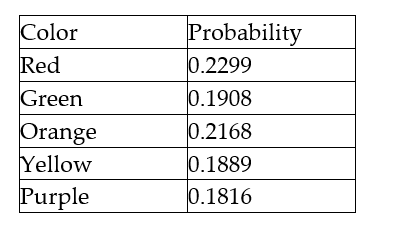A) 0.244
B) 0.324
C) 0.5
D) 0.196
Correct Answer

verified
Correct Answer
verified
Multiple Choice
A probability experiment is conducted in which the sample space of the experiment is  Let event
Let event  . Assume that each outcome is equally likely. List the outcomes in
. Assume that each outcome is equally likely. List the outcomes in  . Find P(
. Find P(  ) .
) .
A) { 3, 4, 5, 11, 12, 13}; ![]()
B) { 3, 4, 5, 10, 11, 12, 13}; ![]()
C) { 11, 12, 13}; ![]()
D) { 6, 7, 8, 9, 10}; ![]()
Correct Answer

verified
Correct Answer
verified
Multiple Choice
The sample space for tossing three fair coins is {HHH, HHT, HTH, HTT, THH, THT, TTH, TTT}. What is the probability of exactly two heads?
A) ![]()
B) ![]()
C) 3
D) ![]()
Correct Answer

verified
Correct Answer
verified
Multiple Choice
Evaluate.
-
A) 15
B) 30
C) 4
D) 180
Correct Answer

verified
Correct Answer
verified
True/False
In a 1-pond bag of skittles the possible colors were red, green, yellow, orange, and purple. The probability of drawing a particular color from that bag is given below. Is this a probability model? 
Correct Answer

verified
Correct Answer
verified
Multiple Choice
A box contains 25 widgets, 4 of which are defective. If 4 are sold at random, find the probability that (a) all are defective (b) none are defective.
A) ![]() ;
; ![]()
B) ![]() ;
; ![]()
C) ![]() ;
; ![]()
D) ![]() ;
; ![]()
Correct Answer

verified
Correct Answer
verified
Multiple Choice
Find the indicated probability. Give your answer as a simplified fraction.
-A researcher at a large university wanted to investigate if a student's seat preference was related in any way to the gender of the student. The researcher divided the lecture room into three sections (1-front, middle of the room, 2-front, sides of the classroom, and 3-back of the classroom, both middle and sides) and noted where his students sat on a particular day of the class. The researcher's summary table is provided below. Suppose a person sitting in the front, middle portion of the class is randomly selected to answer a question. Find the probability the person selected is a female. 
A) ![]()
B) ![]()
C) ![]()
D) ![]()
Correct Answer

verified
Correct Answer
verified
Multiple Choice
Evaluate.
-
A) 2!
B) 4
C) 12
D) ![]()
Correct Answer

verified
Correct Answer
verified
Multiple Choice
If P(A) = 0.72, P(B) = 0.11, and A and B are independent, find P(A|B) .
A) 0.72
B) 0.0792
C) 0.11
D) 0.83
Correct Answer

verified
Correct Answer
verified
Multiple Choice
Find the indicated probability.
-Suppose that M and N are two events, P(M) = 0. 12, P(N) = 0.0 5, and P(M and N) = 0.0 2. What is P(  N) ?
N) ?
A) 0.167
B) 0.150
C) 0.030
D) 0.400
Correct Answer

verified
Correct Answer
verified
Multiple Choice
If you are dealt 6 cards from a shuffled deck of 52 cards, find the probability of getting 3 jacks and 3 aces.
A) ![]()
B) ![]()
C) ![]()
D) ![]()
Correct Answer

verified
Correct Answer
verified
Showing 81 - 91 of 91
Related Exams